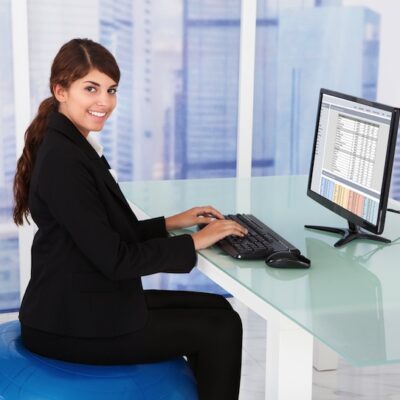Modern day living means that most people work within offices. Regardless of their design, offices all have one thing in common: desks, chairs, and usually computers within a limited area. Although some organisations have invested in gyms and rest areas for their employees, for the most part, facilities to exercise at work are scarce, over-crowded or unavailable.
Staying active while working is vital: We spend the greater part of our days on the job and extended periods of sitting turn off a vital fat-burning enzyme in the body, resulting in accumulated mid-section and abdominal fat. So what can we do? Is there any hope for those of us who are office-bound? Exercise specialists say, “Yes, there is”! There is a range of inventive ways to use your office space to get your body moving and avoid the pitfalls of inactivity.
The key to effectively exercising on the job is to be creative. Devise an easy system for yourself that you write on a post-it, stick somewhere you can see it, and stick to each day. Any movement is better than none at all. Adding short stints of exercise throughout the day will help to burn more calories, release tension, strengthen the immune system and reduce stress. All benefits we can live with, but not without!
Get Moving!
Don’t sit for longer than an hour at a time. Set alarms to remind you to get up, stretch, and visit the kitchen or the bathroom. Swing your arms as you take a short walk and focus your eyes on something far away to alleviate eyestrain.
Stand as you Chat, Walk as You Talk
Take “standing breaks” every hour and work standing up for 5-10 minutes. You’ll burn 25% more calories by doing this. Don’t lean over your desk as you stand: find tasks that make you stay upright, e.g. stand while speaking on the phone, reading or jotting down notes using a clipboard. In addition, if you pace as you work, or walk as you talk on your cell phone, you’ll burn almost four times as many calories as when you are sitting. Grab a colleague and go walking around the block during your lunch break.
Calf and Arm Raises
Standing, place two heavy files of equal or similar weight in your outstretched arms and stand up on tiptoes for 2-5 counts and then come down. Repeat 10-15 times. Two 1-2 litre water bottles can be used, one in each hand as you raise the bottles above your head and bring down to shoulder level. You can also use your handbag in the same way, lifting it above your head and bringing it back down again. Repeat 10-15 times 3-4 times daily. Remember to pull in your stomach muscles as you do this, keep your back straight and your neck and shoulders relaxed.
Ab Attack to Fight the Fat
Do the ab strengthener: contract your ab muscles six times slowly for 6 counts each, then six times quickly for 2 counts each, then six times very slowly for 10 counts each and repeat.
Subtle Tucks For Firmer Butts
Contract your gluteals (rear posterior muscles) any time you need to wait for something, sitting or standing. This means, simply tighten your buttocks as you stand or sit, hold for 5-10 counts and then relax. Repeat 15 times. Remember that if you are wearing figure-hugging clothing with someone behind you, this may attract unwanted attention so be aware of this.
Sit on a Pilates Ball
A firmly inflated exercise ball can serve as a good chair. By exchanging your traditional chair for a ball, you will improve your balance and tone your core muscles while sitting at your desk. During the day practice lifting one foot off the ground to improve balance.
Handy Fitness Equipment
Keep resistance bands (also known as therabands) or small hand weights in a desk drawer or cabinet. Do arm curls and arm stretches using these between meetings or during your lunch break. Lift your arms outwards at shoulder level, hold each side of a theraband with your hands about 10 cm apart, and stretch your hands further apart and bring back to starting position. Do 2 sets of 10-20.
Regularly Raise Your Heart Rate
Improving your heart rate variability (your heart’s ability to jump from resting to 60 or 70%) has been shown to increase longevity and decrease heart disease risk. To do this, while seated, pump both arms over your head for 30 seconds, then rapidly tap your feet on the floor, drill style, for 30 seconds. Repeat 3-5 times. Or do jumping jacks for 60 seconds or running on the spot with knees high.
Smart Steps for Firmer Legs
1) Do one-legged squats (hold onto a wall or table for support) while waiting for a web page to load, the copier to print your reports, or faxes to come through.
2) Stand with one leg straight and try to kick your buttocks with the other. Repeat 10 times each leg.
3) Sitting in your chair, lift one leg off the seat, extend it out straight, hold for 2 seconds; then lower your foot (stop short of the floor) and hold for several seconds. Switch; do each leg 15 times.
Subtle Chair Workouts
1) To work your chest and shoulders, place both hands on your chair arms and slowly lift your bottom off the chair. Lower your body back down, but stop just before the seat and hold for a few seconds. Repeat 15 times.
2) To stretch your back and strengthen your biceps, place your hands on your desk and hang on. Slowly push your chair back until your head is between your arms and you are looking down at the floor. Then, slowly pull yourself back. Repeat 15 times.
Let’s not allow our fear of embarrassment or disapproval discourage us from exercising at work. The more you invest in your body’s health now, the more quality of life you will reap in the future. Your colleagues may even admire your efforts, be inspired or ask to join you. If on the rare occasion, one of your colleagues does find you in a less conventional position, for example, sitting on your chair two feet from the desk, stretched out, staring at the floor, you could pretend you dropped a pen, but how about telling them the truth, exclaiming “This feels great! Why don’t you try it.’
Live in Joburg? Join one of my Pilates classes in Horison, Roodepoort. Contact: admin@better4life.co.za
By Charlotte Jean

